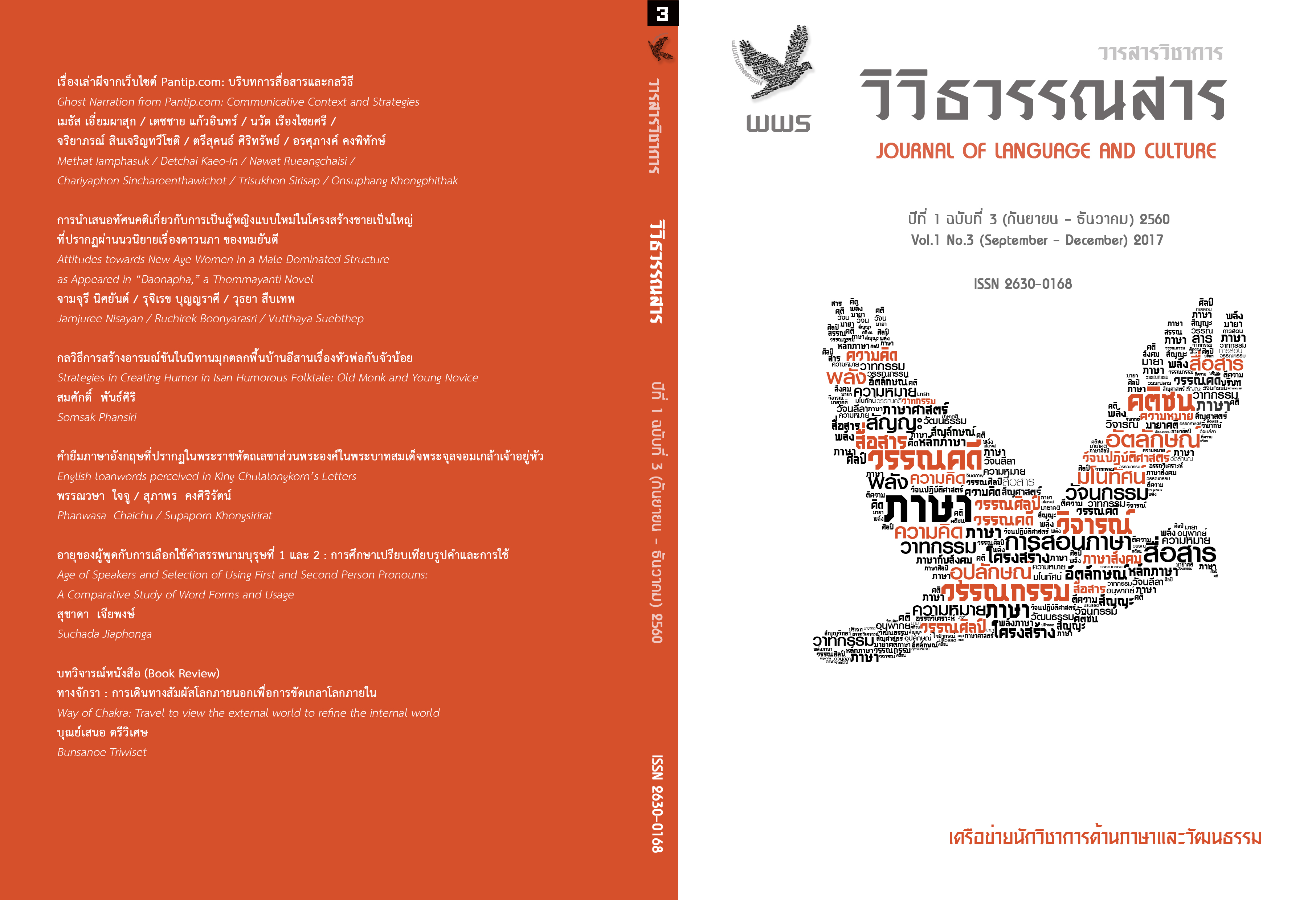กลวิธีการสร้างอารมณ์ขันในนิทานมุกตลกพื้นบ้านอีสานเรื่องหัวพ่อกับจัวน้อย
Main Article Content
บทคัดย่อ
บทความวิชาการนี้ มีวัตถุประสงค์เพื่อศึกษากลวิธีการสร้างอารมณ์ขันในนิทานมุกตลกพื้นบ้านอีสานเรื่องหัวพ่อกับจัวน้อยจากนิทาน 28 เรื่องจากต้นฉบับเดิม 45 เรื่องใช้กรอบแนวคิดทฤษฎีการสร้างอารมณ์ขันและการใช้ภาษาเพื่อสร้างอารมณ์ขันในการวิเคราะห์ ผลการศึกษาพบว่า การสร้างอารมณ์ขันเกิดจากปมการขัดแย้งของสองตัวละครหลักในวงการศาสนา คือหลวงพ่อและเณรน้อย ซึ่งเป็นไปตามทฤษฎีการข่มท่าน ทฤษฎีการผิดฝาผิดตัว และทฤษฎีการปลดปล่อย ปมเรื่องที่ก่อให้เกิดอารมณ์ขันได้แก่ การถูกหลอกความ โง่เขลา การใช้กลอุบาย ความบังเอิญ การเอาเปรียบ การทำผิดศีล ส่วนการใช้ภาษาเพื่อสร้างอารมณ์ขัน พบว่า มีการใช้คำผวน การใช้สัญลักษณ์เพศ การพูดเล่นคารม การใช้ปริศนา การใช้คำที่มีความหมายอ้อม
Article Details
รูปแบบการอ้างอิง
Phansiri, S. (2019). กลวิธีการสร้างอารมณ์ขันในนิทานมุกตลกพื้นบ้านอีสานเรื่องหัวพ่อกับจัวน้อย. Journal of Variety in Language and Literature, 1(3), 53–84. สืบค้น จาก https://so06.tci-thaijo.org/index.php/wiwitwannasan/article/view/192711
ประเภทบทความ
บทความวิชาการ/บทความวิจัย
ลิขสิทธิ์ของบทความเป็นของวารสาร การพิมพ์ซ้ำจะต้องได้ร้บการอนุญาตจากบรรณาธิการวารสาร
เอกสารอ้างอิง
Attardo, S. (1994). Linguistic Theories of Humor. New York: Mouton de Gruyter.
Chanbanchee, Y. (2008). The Techniques of Thai Humour in the Prose of Ketsaepsawas
Palakawong Na Ayudhya. Master’s Thesis, Graduate School,
Srinakharinwirot University.
Klahwikgid, W. (2005). Humour in text Sms. Master’s Thesis, Graduate School,
Srinakharinwirot University.
Liaophenseng, S (2009). Khati chon witthaya. (In Thai) [Folklore]. Khonkean: khlang nana
witthaya.
Sastri, S. (1983). Rai ngan wichai khwam talok nai lakhon nok. (in Thai) [Research Report
on Humorous Structure in Lakhon Nok]. Bangkok: Faculty of Arts,
Chulalongkorn University.
Senasui, P. S. (2003). Nithan Huapho Kap Chua Noi. (In Thai). [Tale of Old Monk and Young
Novice]. Khonkean: Maha-Utr Press.
Wimonchan, S. (2005). Khao chai katun. (in Thai) [Understanding Cartoon].
Bangkok: Rueankaeo.
Chanbanchee, Y. (2008). The Techniques of Thai Humour in the Prose of Ketsaepsawas
Palakawong Na Ayudhya. Master’s Thesis, Graduate School,
Srinakharinwirot University.
Klahwikgid, W. (2005). Humour in text Sms. Master’s Thesis, Graduate School,
Srinakharinwirot University.
Liaophenseng, S (2009). Khati chon witthaya. (In Thai) [Folklore]. Khonkean: khlang nana
witthaya.
Sastri, S. (1983). Rai ngan wichai khwam talok nai lakhon nok. (in Thai) [Research Report
on Humorous Structure in Lakhon Nok]. Bangkok: Faculty of Arts,
Chulalongkorn University.
Senasui, P. S. (2003). Nithan Huapho Kap Chua Noi. (In Thai). [Tale of Old Monk and Young
Novice]. Khonkean: Maha-Utr Press.
Wimonchan, S. (2005). Khao chai katun. (in Thai) [Understanding Cartoon].
Bangkok: Rueankaeo.


